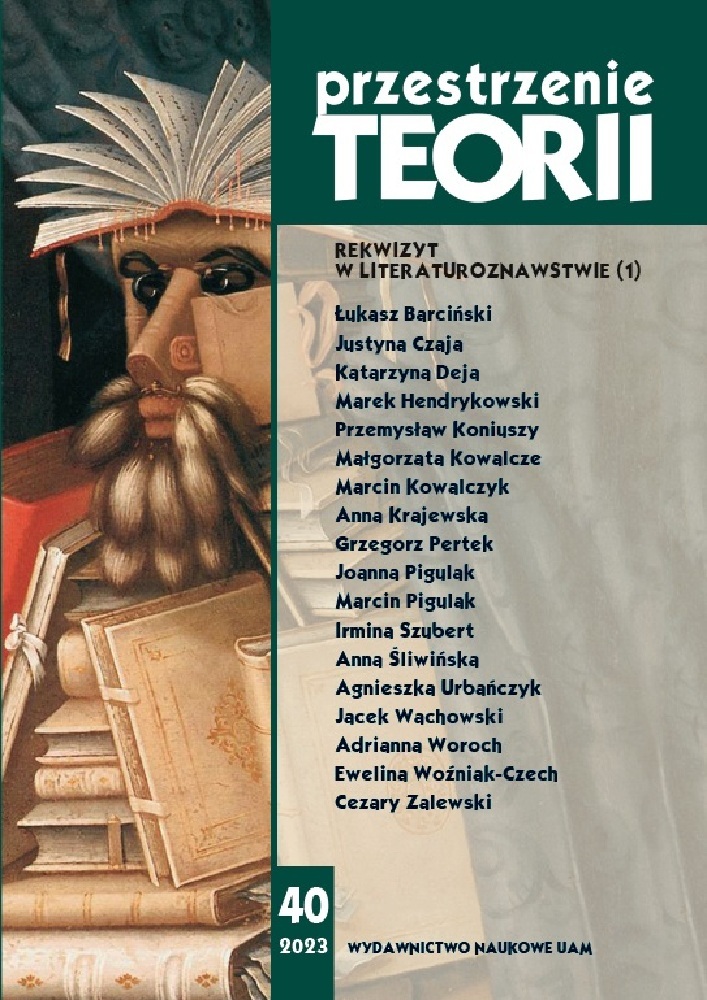Abstrakt
The article is an attempt to describe the conditions in which the body assumes the role of a prop – it becomes an object organizing individual and social life. For such a process to take place, it is necessary to disconnect the body from the Self. It comes with his death. Funeral practices that change the social status of the body can take a monistic or dualistic form. The former make the body a relic and are based on the belief that soma is connected with its spiritual essence. The latter, on the contrary, points to the impermanence of such a connection. In this way, the body becomes a prop, an object, an object, and a tool for funeral performances.
Bibliografia
Armstrong D.M., A Materialist Theory of the Mind, London 1971.
Armstrong D.M., Malcolm N., Conciousness and Causality, Oxford 1984.
Arystoteles, O duszy, przeł. P. Siwek, Warszawa 1972.
Benedict R., Wzory kultury, przeł. J. Prokopiuk, Warszawa 1999.
Bettelheim B., Rany symboliczne, przeł., wstęp i oprac. D. Danek, Warszawa 1989.
Biblia Tysiąclecia. Pismo Święte Starego i Nowego Testamentu, Warszawa 1987.
Burszta W.J., Antropologia kultury. Tematy, teorie, interpretacje, Poznań 1998.
Cackowski Z., Współczesne teorie umysłu. „Teoria identyczności”, „Studia Filozoficzne” 1980, nr 1, s. 3–21.
Caillois R., Człowiek i sacrum, przeł. A. Tatarkiewicz, E. Burska, Warszawa 1995.
Cassam Q., Introspection and Bodily Self-Ascription, [w:] The Body and the Self, red. J. Bermúdez, A. Marcel, N. Eilan, Cambridge 1998, s. 311–336.
Chirpaz F., Ciało, przeł. J. Migasiński, Warszawa 1988.
Chróścicki J.A., Pompa funebris. Z dziejów kultury staropolskiej, Warszawa 1974.
Current BODY WORLDS exhibitions worldwide – At a glance! (dostęp: 28.08.2023).
Eliade M., Człowiek i sacrum, przeł. A. Tatarkiewicz, E. Burska, Warszawa 1995.
Eliade M., Opętanie w kulcie Dionizosa, przeł. L. Kolankiewicz, „Dialog” 1987, nr 11–12.
Encyclopedia Anatomica. Museo La Specola Florence, Cologne 2004.
Geertz C., Local knowledge. Further Essays in Interpretive Anthropology, New York 1983. Geertz C., O gatunkach zmąconych, przeł. Z. Łapiński, „Teksty Drugie” 1990, nr 2, s. 112–130.
Girard R., Sacrum i przemoc, cz. 2, przeł. M. i J. Plecińscy, Poznań 1994.
Herodot, Dzieje, przeł. S. Hammer, Warszawa 1954.
Huxley F., Affable Savages, New York 1966.
Jaspers K., Wiara filozoficzna wobec objawienia, przeł. G. Sowiński, wstęp E. Wolicka, Kraków 1999.
Kołakowski L., Horror metaphysicus, Kraków 2012.
Krzak Z., Megality Europy, Warszawa 1994.
Kuchowicz Z., O biologiczny wymiar historii, Warszawa 1985.
Levinas E., Całość i nieskończoność, przeł. M. Kowalska, wstęp B. Skarga, Warszawa 1998.
Lyons J., Semantyka, przeł. A. Wiensberg, Warszawa 1984.
Malinowski B., Mit, magia, religia, przeł. B. Leś, D. Praszałowicz, red. A.K. Paluch, [w:] idem, Dzieła, t. 7, Warszawa 1990.
Margolis J., Persons and Minds. The Prospects of Nonreductive Materialism, London 1978. Merleau-Ponty M., Proza świata. Eseje o mowie, przeł., wyb., wstęp i oprac. S. Ciechowicz, Warszawa 1976.
Ortiz F., Abakua: rytuał i tragedia, przeł, K. Górna-Urbańska, „Dialog” 1989, nr 3.
Pierce Ch., Collected Papers, red. C. Hartshorne, P. Weiss, t. 2, Cambridge 1958.
Platon, Fedon, przeł. W. Witwicki, [w:] idem, Dialogi, Warszawa 1993.
Popper K.R., Eccles J.C., The Self and Its Brain, London 1977. DOI: https://doi.org/10.1007/978-3-642-61891-8
Quine W.V., Filozoficzny postęp w teorii języka, przeł. B. Stanosz, [w:] Lingwistyka a filozofia. Współczesny spór o filozoficzne założenia teorii języka, red. B. Stanosz, Warszawa 1977, s. 514–515.
Reale G., Historia filozofii starożytnej, t. 2, przeł. I. Zieliński, Lublin 1997.
Roux J.P., Krew. Mity, symbole i rzeczywistość, przeł. M. Pyrek, Kraków 1994.
Supady J., Śmierć jako czynnik sprawczy w historii, [w:] Problemy współczesnej tanatologii. Medycyna-antropologia kultury – humanistyka. Materiały III Konferencji
Krajowej TANATOS 99, red. J. Kolbuszewski, Wrocław 1999, s. 15–19.
Symbole i symbolika, red. M. Głowiński, Warszawa 1990.
Thomas L.V., Trup. Od biologii do antropologii, przeł. K. Kocjan, Łódź 1991.
Von Hagens forced to return controversial corpses to China | World news | The Guardian (dostęp: 28.08.2023).
Wachowski J., Kilka uwag o poznaniu somatycznym i aktorstwie, „Poznańskie Studia Polonistyczne. Seria Literacka” 1998, z. XXV, s. 135–148.
Wieczorkiewicz A., Muzeum ludzkich ciał. Anatomia spojrzenia, Gdańsk 2000.
Licencja
Prawa autorskie (c) 2023 Jacek Wachowski

Utwór dostępny jest na licencji Creative Commons Uznanie autorstwa – Użycie niekomercyjne – Bez utworów zależnych 4.0 Międzynarodowe.
Autorzy
Autorzy tekstów przyjętych do publikacji w czasopiśmie „Przestrzeniach Teorii” są zobowiązani do wypełnienia, podpisania i odesłania na adres redakcji umowy o udzielenie nieodpłatnej licencji do utworów, z zobowiązaniem do udzielania sublicencji CC.
Zgodnie z umową, autorzy tekstów opublikowanych w czasopiśmie „Przestrzeniach Teorii” udzielają Uniwersytetowi im. Adama Mickiewicza w Poznaniu niewyłącznej i nieodpłatnej licencji oraz zezwalą na użycie sublicencji Creative Commons Attribution-NonCommercial-NoDerivatives 4.0 International (CC BY-NC-ND 4.0).
Autorzy zachowują prawa do dalszego, swobodnego rozporządzania utworem.
Autorzy, którzy wykorzystują w swoim tekście cudze utwory (np. ilustracje, fotografie) proszeni są o dostarczenie do redakcji czasopisma zgodę na publikację od uprawnionych podmiotów.
Użytkownicy
Zainteresowani użytkownicy internetu uprawnieni są do korzystania z utworów opublikowanych po 2015 roku „Przestrzeniach Teorii” tylko w calach niekomercyjnych, pod następującymi warunkami:
- uznanie autorstwa - obowiązek podania wraz z rozpowszechnionym utworem, informacji, o autorstwie, tytule, źródle (odnośniki do oryginalnego utworu, DOI) oraz samej licencji;
- bez tworzenia utworów zależnych - utwór musi być zachowany w oryginalnej postaci, nie można bez zgody twórcy rozpowszechniać np. tłumaczeń, opracowań.
Do wszystkich tekstów opublikowanych przed 2015 r. prawa autorskie są zastrzeżone.
Inne
Uniwersytet im. Adama Mickiewicza w Poznaniu zachowuje prawo do czasopisma jako całości (układ, forma graficzna, tytuł, projekt okładki, logo itp.).

